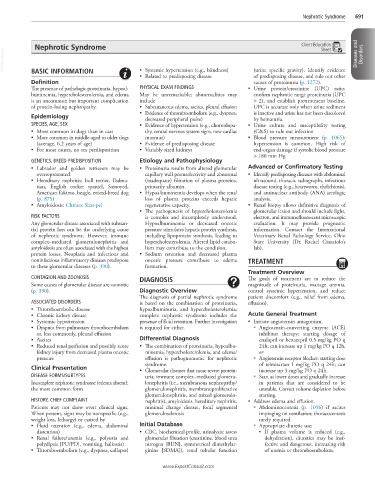Page 1370 - Cote clinical veterinary advisor dogs and cats 4th
P. 1370
Nephrotic Syndrome 691
Nephrotic Syndrome Client Education
Sheet
VetBooks.ir Diseases and Disorders
• Systemic hypertension (e.g., blindness)
BASIC INFORMATION
• Related to predisposing disease (urine specific gravity). Identify evidence
of predisposing disease, and rule out other
Definition causes of proteinuria (p. 1272).
The presence of pathologic proteinuria, hypoal- PHYSICAL EXAM FINDINGS • Urine protein/creatinine (UPC) ratio:
buminemia, hypercholesterolemia, and edema May be unremarkable; abnormalities may confirm nephrotic range proteinuria (UPC
is an uncommon but important complication include > 2), and establish pretreatment baseline.
of protein-losing nephropathy. • Subcutaneous edema, ascites, pleural effusion UPC is accurate only when urine sediment
• Evidence of thromboembolism (e.g., dyspnea, is inactive and urine has not been discolored
Epidemiology decreased peripheral pulse) by hematuria.
SPECIES, AGE, SEX • Evidence of hypertension (e.g., choroidopa- • Urine culture and susceptibility testing
• More common in dogs than in cats thy, central nervous system signs, new cardiac (C&S) to rule out infection
• More common in middle-aged to older dogs murmur) • Blood pressure measurement (p. 1065):
(average, 6.2 years of age) • Evidence of predisposing disease hypertension is common. High risk of
• For most causes, no sex predisposition • Variably sized kidneys end-organ damage if systolic blood pressure
> 180 mm Hg
GENETICS, BREED PREDISPOSITION Etiology and Pathophysiology
• Labrador and golden retrievers may be • Proteinuria results from altered glomerular Advanced or Confirmatory Testing
overrepresented. capillary wall permselectivity and abnormal • Identify predisposing diseases with abdominal
• Hereditary nephritis: bull terrier, Dalma- (inadequate) filtration of plasma proteins, ultrasound, thoracic radiographs, infectious
tian, English cocker spaniel, Samoyed, primarily albumin. disease testing (e.g., heartworm, ehrlichiosis),
American Eskimo, beagle, mixed-breed dog • Hypoalbuminemia develops when the renal and antinuclear antibody (ANA) serologic
(p. 875) loss of plasma proteins exceeds hepatic analysis.
• Amyloidosis: Chinese Shar-pei regenerative capacity. • Renal biopsy allows definitive diagnosis of
• The pathogenesis of hypercholesterolemia glomerular lesion and should include light,
RISK FACTORS is complex and incompletely understood. electron, and immunofluorescent microscopic
Any glomerular disease associated with substan- Hypoalbuminemia or decreased oncotic evaluation. It may provide prognostic
tial protein loss can be the underlying cause pressure stimulates hepatic protein synthesis, information. Contact the International
of nephrotic syndrome. However, immune including lipoprotein synthesis, leading to Veterinary Renal Pathology Service, Ohio
complex–mediated glomerulonephritis and hypercholesterolemia. Altered lipid catabo- State University (Dr. Rachel Cianciolo’s
amyloidosis are often associated with the highest lism may contribute to the condition. lab).
protein losses. Neoplasia and infectious and • Sodium retention and decreased plasma
noninfectious inflammatory diseases predispose oncotic pressure contribute to edema TREATMENT
to these glomerular diseases (p. 390). formation.
Treatment Overview
CONTAGION AND ZOONOSIS DIAGNOSIS The goals of treatment are to reduce the
Some causes of glomerular disease are zoonotic magnitude of proteinuria, manage uremia,
(p. 390). Diagnostic Overview control systemic hypertension, and reduce
The diagnosis of partial nephrotic syndrome patient discomfort (e.g., relief from edema,
ASSOCIATED DISORDERS is based on the combination of proteinuria, effusion).
• Thromboembolic disease hypoalbuminuria, and hypercholesterolemia;
• Chronic kidney disease complete nephrotic syndrome includes the Acute General Treatment
• Systemic hypertension presence of fluid retention. Further investigation • Initiate angiotensin antagonism.
• Dyspnea from pulmonary thromboembolism is required for either. ○ Angiotensin-converting enzyme (ACE)
or, less commonly, pleural effusion inhibitor therapy: starting dosage of
• Ascites Differential Diagnosis enalapril or benazepril 0.5 mg/kg PO q
• Reduced renal perfusion and possibly acute • The combination of proteinuria, hypoalbu- 24h; can increase up 1 mg/kg PO q 12h,
kidney injury from decreased plasma oncotic minemia, hypercholesterolemia, and edema/ or
pressure effusion is pathognomonic for nephrotic ○ Angiotensin receptor blocker: starting dose
syndrome. of telmisartan 1 mg/kg PO q 24h; can
Clinical Presentation • Glomerular diseases that cause severe protein- increase up 3 mg/kg PO q 24h.
DISEASE FORMS/SUBTYPES uria: immune complex–mediated glomeru- ○ Start at lower doses and gradually increase
Incomplete nephrotic syndrome (edema absent): lonephritis (i.e., membranous nephropathy/ in patients that are considered to be
the most common form glomerulonephritis, membranoproliferative unstable. Correct volume depletion before
glomerulonephritis, and mixed glomerulo- starting.
HISTORY, CHIEF COMPLAINT nephritis), amyloidosis, hereditary nephritis, • Address edema and effusion.
Patients may not show overt clinical signs. minimal change disease, focal segmental ○ Abdominocentesis (p. 1056) if ascites
When present, signs may be nonspecific (e.g., glomerulosclerosis impinging on ventilation; thoracocentesis
weight loss, lethargy) or caused by rarely required
• Fluid retention (e.g., edema, abdominal Initial Database ○ Appropriate diuretic use:
distention) • CBC, biochemical profile, urinalysis: assess ■ If plasma volume is reduced (e.g.,
• Renal failure/uremia (e.g., polyuria and glomerular filtration (creatinine, blood urea dehydration), diuretics may be inef-
polydipsia [PU/PD], vomiting, halitosis) nitrogen [BUN], symmetrical dimethylar- fective and dangerous, increasing risk
• Thromboembolism (e.g., dyspnea, collapse) ginine [SDMA]), renal tubular function of uremia or thromboembolism.
www.ExpertConsult.com

